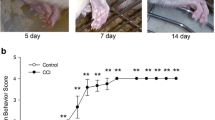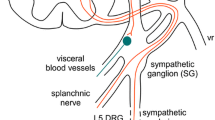Abstract
To clarify the role of Angiotensin II in the regulation of sensory signaling, we characterized the AT1 expression in neuronal subpopulation of lower lumbar dorsal root ganglia under normal conditions and its alteration in neuropathic pain model. The characterization of AT1 expression was done under control and after the chronic constriction injury induced by four loose ligatures of the sciatic nerve representing the model of posttraumatic painful peripheral neuropathy. Major Angiotensin II receptor type was expressed in approximately 43 % of small-sized and 62 % of large-sized neurons in control. The AT1 overexpression after sciatic nerve ligation lasting 7 days was detected predominantly in small-sized AT1 immunoreactive neurons (about 38 % increase). Chronic constriction injury caused a statistically marked increase in number of the small-sized peptidergic (CGRP immunoreactive) neuronal subpopulation expressing AT1 (about 64 %). The subpopulations of AT1-immunoreactive and nonpeptide-containing primary sensory neurons revealed by IB4 binding, tyrosine hydroxylase- and parvalbumin-immunoreactive neurons were not markedly changed. Our results indicate that: (1) the AT1 overexpression after the chronic constriction injury is an important factor in Angiotensin II-potentiated pain perception; (2) Angiotensin II is involved in pathological mechanisms of neuropathic pain and this effect can be mediated perhaps in combination with other neuropeptides synthesized in the primary sensory neurons.









Similar content being viewed by others
References
Averill S, McMahon SB, Clary DO, Reichardt LF, Priestley JV (1995) Immunocytochemical localization of trkA receptors in chemically identified subgroups of adult rat sensory neurons. Eur J Neurosci 7:1484–1494
Baimbridge KG, Miller JJ, Parkes CO (1982) Calcium binding protein distribution in the rat brain. Brain Res 239:519–525
Baimbridge KG, Mody I, Miller JJ (1985) Reduction of rat hippocampal calcium-binding protein following commissural, amygdala, septal, perforant path and olfactory bulb kindlings. Epilepsia 26:460–465
Bennett GJ, Xie YK (1988) A peripheral mononeuropathy in rat that produces disorders of pain sensation like those seen in man. Pain 33:87–107
Berchtold MW, Celio MR, Heizmann CW (1984) Parvalbumin in non-muscle tissues of the rat. J Biol Chem 259:5189–5196
Brumovsky P, Villar MJ, Hökfelt T (2006) Tyrosine hydroxylase is expressed in a subpopulation of small dorsal root ganglion neurons in the adult mouse. Exp Neurol 200:153–165
Buck SH, Walsh JJ, Yamamura HI, Burks TF (1982) Neuropeptides in sensory neurons. Life Sci 30:1857–1866
Caillard O, Moreno H, Schwaller B, Llano I, Celio MR, Marty A (2000) Role of the calcium-binding protein parvalbumin in short-term synaptic plasticity. Proc Natl Acad Sci USA 97:13372–13377
Carr PA, Yamamoto T, Karmy G, Baimbridge KG, Nagy JI (1989) Parvalbumin is highly colocalized with calbindin D28 k and rarely with calcitonin gene-related peptide in dorsal root ganglia neurons of rat. Brain Res 497:163–170
Celio MR (1990) Calbindin D-28 k and parvalbumin in the rat nervous system. Neurosci. 35:375–475
Jöhren O, Inagami T, Saavedra JM (1995) AT1A, AT1B and AT2 angiotensin II receptor subtype gene expression in rat brain. NeuroReport 6:2549–2552
Macova M, Armando I, Zhou J, Baiardi G, Tyurmin D, Larrayoz-Roldan I, Saavedra JM (2008) Estrogen reduces aldosterone, upregulates adrenal angiotensin II AT2 receptors and normalizes adrenomedullary Fra-2 in ovariectimized rats. Neuroendocrinology 88:276–286
McManis PG, Schmelzer JD, Zollman PJ, Low PA (1997) Blood flow and autoregulation on somatic and autonomic ganglia. Comparison with sciatic nerve. Brain 120:445–449
Molliver DC, Radeke MJ, Feinstein SC, Snider WD (1995) Presence or absence of TrkA protein distinguishes subsets of small sensory neurons with unique cytochemical characteristics and dorsal horn projections. J Comp Neurol 361:404–416
Obata K, Yamanaka H, Fukuoka T, Yi D, Tokunaga A, Hashimoto N, Yoshikawa H, Noguchi K (2003) Contribution of injured and uninjured dorsal root ganglion neurons to pain behavior and the changes in gene expression following chronic constriction injury of the sciatic nerve in rats. Pain 101:65–77
Oz M, Yang KH, Renaud LP, O´Donovan MJ (2005) Presynaptic Angiotensin II AT1 receptors enhance inhibitory and excitatory synaptic neurotransmission to motoneurons and other ventral horn neurons in neonatal rat spinal cord. J Neurophysiol 94:1405–1412
Patil J, Schwab A, Nussberger J, Schaffner T, Saavedra JM, Imboden H (2010) Intraneuronal angiotensinergic system in rat and human dorsal root ganglia. Reg Pept 162:90–98
Paul M, Mehr AP, Kreutz R (2006) Physiology of local rennin-angiotensin systems. Physiol Rev 86:747–803
Pavel J, Tang H, Brimijoin S, Moughamian A, Nishioku T, Benicky J, Saavedra JM (2008) Expression and transport of Angiotensin II AT1 receptors in spinal cord, dorsal root ganglia and sciatic nerve of the rat. Brain Res 1246:111–122
Pavel J, Hricova L, Jergova S, Lukacova N (2011) The impact of short-lasting repeated vibrations on retrograde axonal transport, the expression of CGRP and parvalbumin in lower lumbar dorsal root ganglia. Brain Res 1396:1–10
Pavel J, Oroszova Z, Hricova L, Lukacova N (2013) Effect of subpressor dose of angiotensin II on pain-related behavior in relation with neuronal injury and activation of satellite glial cells in the rat dorsal root ganglia. Cell Mol Neurobiol 33:681–688
Pelegrini-da-Silva Martins AR, Prado WA (2005) A new role for the rennin-angiotensin system in the rat periaqueductal gray matter: angiotensin receptor-mediated modulation of nociception. Neurosci 132:453–463
Saavedra JM (1992) Brain and pituitary angiotensin. Endocr Rev 13:329–380
Saavedra JM (2012) Angiotensin II AT1 receptor blockers as treatment for inflammatory brain disorders. Clin Sci (Lond) 123:567–590
Sapunar D, Ljubkovic M, Lirk P, McCallum JB, Hogan QH (2005) Distinct membrane effects of spinal nerve ligation on injured and adjacent dorsal root ganglion neurons in rats. Anesthesiology 103:360–376
Sapunar D, Kostic S, Banozic A, Puljak L (2012) Dorsal root ganglion–a potential new therapeutic target for neuropathic pain. J Pain Res 5:31–38
Snider WD, McMahon SB (1998) Tackling pain at the source: new ideas about nociceptors. Neuron 20:629–632
Swett JE, Torigoe Y, Elie VR, Bourassa CM, Miller PG (1991) Sensory neurons of the rat sciatic nerve. Exp Neurol 114:82–103
Takeda M, Takahashi M, Matsumoto S (2009) Contribution of the activation of satellite glia in sensory ganglia to pathological pain. Neurosci Biobehav Rev 33:784–792
Tang H, Pavel J, Saavedra JM, Brimijoin S (2008) Angiotensin II type 1 receptors may not influence response of spinal autonomic neurons to axonal damage. Neurol Res 30:751–760
White SR, Penner JD, Speth RC, Chan JYH (1988) Angiotensin II receptors in the lumbar spinal cord of the rat. Brain Res 441:195–201
Wu W, Zhang Y, Ballew JR, Fink G, Wang DH (2000) Development of hypertension induced by subpressor infusion of angiotensin II: role of sensory system. Brain Res 817:123–131
Xie WR, Deng H, Li H, Bowen TL, Strong JA, Zhang JM (2006) Robust increase of cutaneous sensitivity, cytokine production and sympathetic sprouting in rats with localized inflammatory irritation of the spinal ganglia. Neuroscience 142:809–822
Yoshizawa H, Kobayashi S, Hachiya Y (1991) Blood supply of nerve roots and dorsal root ganglia. Orthop Clin N Am 22:195–211
Yosten GLC, Samson WK (2012) Cardiovascular neuroendocrinology. In: Fink G, Pfaff DW, Levine JE (eds) Handbook of Neuroendocrinology, 1st edn. Academic Press, San Diego, pp 307–327
Acknowledgments
The authors would like to thank Mrs. I. Vrabelova for excellent technical assistance. The study was supported by the VEGA Grants No’s. 2/0160/16 and 2/0173/14 from the Slovak Academy of Sciences.
Author information
Authors and Affiliations
Corresponding author
Electronic supplementary material
Below is the link to the electronic supplementary material.
Rights and permissions
About this article
Cite this article
Oroszova, Z., Hricova, L., Stropkovska, A. et al. The Characterization of AT1 Expression in the Dorsal Root Ganglia After Chronic Constriction Injury. Cell Mol Neurobiol 37, 545–554 (2017). https://doi.org/10.1007/s10571-016-0396-6
Received:
Accepted:
Published:
Issue Date:
DOI: https://doi.org/10.1007/s10571-016-0396-6




